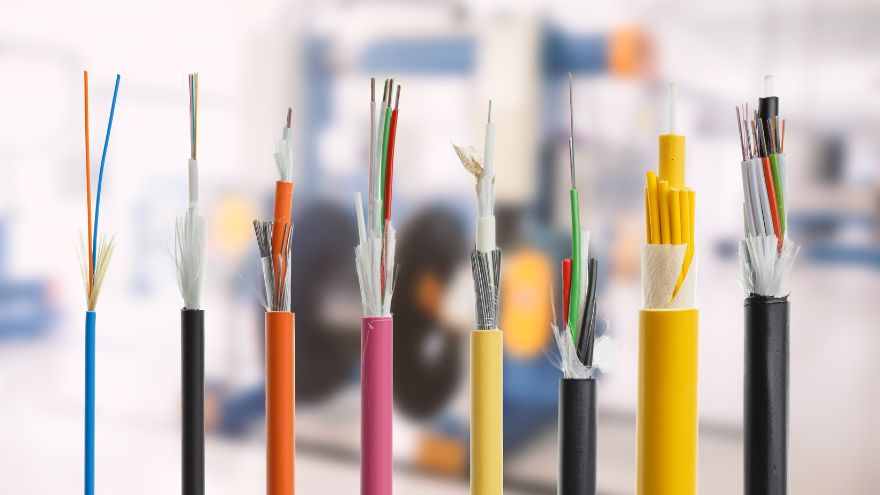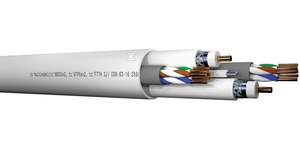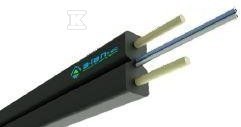Optical fiber is one of the technological achievements that in recent decades has radically changed our approach to communication, data transmission and the functioning of industrial infrastructure. Although this small, thin fiberglass does not seem impressive at first glance, its impact on the development of fields such as telecommunications, industry, science and medicine is difficult to overestimate.

Check out fiber optic cables at the Onninen wholesaler
Where are optical fibers used in industry?
Fiber optics, or optical cables, are an extremely versatile and effective connection infrastructure that is used in many industrial fields. Their unique properties, such as high bandwidth and resistance to interference, make them an indispensable element of modern technologies.
 In the medical field, optical fibers are used in endoscopes and laparoscopes, enabling accurate imaging and diagnostic tests. Fiberscopes allow for flexible inspection inside the patient's body, which significantly increases the precision of diagnoses and eliminates the need for more invasive procedures.
In the medical field, optical fibers are used in endoscopes and laparoscopes, enabling accurate imaging and diagnostic tests. Fiberscopes allow for flexible inspection inside the patient's body, which significantly increases the precision of diagnoses and eliminates the need for more invasive procedures.
In aviation and space, optical fibers play an important role in navigation, communication and sensory systems. They ensure reliable connections and data transmission in extreme space conditions.
Additionally, optical fibers are an area of intense research and innovation. Their use is developing in areas such as fiber optic sensors, light energy recuperation and food control technologies. As technology advances, fiber optics are playing an increasingly important role in industry, enabling fast and reliable communication and precise monitoring and control of production processes. They are a key element of modern industrial infrastructure and are constantly developing their capabilities in various fields.
Types of fiber optic connectors
There are many types and standards in the field of optical fibers, and choosing the right types of connectors and optical fibers is crucial for effective data transmission. The basic types of fiber optics are single-mode (SM) and multi-mode (MM) fibers.
Multimode fiber optics
Multimode (MM) fibers feature a wider core, typically in 50/125 (OM2) or 62.5/125 standards. They are used to transmit data at speeds up to 10 Gbps on wavelengths of 850 nm or 1320 nm. In these optical fibers, the light source is usually an LED, and the maximum transmission distance is about 550 meters at a speed of 1G.
Single-mode fiber optics
Single-mode (SM) fibers consist of a very small core, usually of the 9/125 standard. In this type of optical fibers, the light source is a laser. Single-mode fiber optics are used in applications requiring long transmission ranges of up to 120 kilometers.
 It is also worth paying attention to the different types of fiber optic connectors. Popular connectors are LC, ST and SC. The LC connector is often used in SFP modules and is small, which facilitates dense cable management. ST connectors feature a stronger mounting provided by a metal nut, which prevents the fiber from slipping out. SC connectors use a latching mechanism, which guarantees connection stability.
It is also worth paying attention to the different types of fiber optic connectors. Popular connectors are LC, ST and SC. The LC connector is often used in SFP modules and is small, which facilitates dense cable management. ST connectors feature a stronger mounting provided by a metal nut, which prevents the fiber from slipping out. SC connectors use a latching mechanism, which guarantees connection stability.
When selecting optical fibers and connectors, it is also important to consider the transmission speed, such as Fast Ethernet, Gigabit Ethernet, or 10 Gigabit Ethernet, to ensure compliance with the IEEE 802.3 standard. Therefore, when designing the network infrastructure, it is worth taking into account the type of optical fiber, the type of connector and the expected transmission speed to ensure effective and reliable data transmission.
Fiber optic connectors in the Onninen wholesaler
Fiber optic connectors play a key role in today's advanced communication systems and IT networks. They allow for the effective connection of thousands of kilometers of optical fibers, creating coherent networks with high capacity and reliability. In wholesalers specializing in telecommunications infrastructure, such as Onninen, you can find a wide selection of different types and types of fiber optic connectors.
Elpio universal fiber optic cable tc'GYFX-12J SM 9/125, 6.5mm, G652D (2km) is a perfect solution for telecommunications and ICT networks. Thanks to its single-tube design and 12 optical fibers, it ensures reliable and fast data transmission. It is a compact and easy-to-install cable that guarantees communication security and minimal signal loss.
 FTTH flat fiber optic cable SM 2J 9/125 LSOH white - ALANTEC Universal (outdoor-indoor) flat cables for use in FTTH systems, light, reinforced structure, high flexibility and resistance to pulling, completely dielectric, dry medium, LSOH jacket, resistant to UV radiation, reinforced with two 0.4mm ARP rods, tension force: installation: 80N, temperature range from -20+60 [°C] - equivalent: ZW-NOTKSdp.
FTTH flat fiber optic cable SM 2J 9/125 LSOH white - ALANTEC Universal (outdoor-indoor) flat cables for use in FTTH systems, light, reinforced structure, high flexibility and resistance to pulling, completely dielectric, dry medium, LSOH jacket, resistant to UV radiation, reinforced with two 0.4mm ARP rods, tension force: installation: 80N, temperature range from -20+60 [°C] - equivalent: ZW-NOTKSdp.
The tc multikabel/350 multimedia cable is a bundle of cables enclosed in one PVC jacket. Includes 2 tc'680 Cu coaxial cables, 2 tc'UTP 5e cables, and 657 A1 dual-fiber optical fiber
High-quality component cables, in coaxial cables the shield foil is glued to the dielectric, which ensures full electromagnetic tightness. FTTH 2J optical fiber reinforced with FRP rods, UTP cat. 5e, metric tags. Recommended for DEVELOPMENT applications, compliant with the requirements of the so-called Building Regulations of 2012. One cable meets the Regulation on telecommunications installations, cabling takes much less time, saving up to 50%.